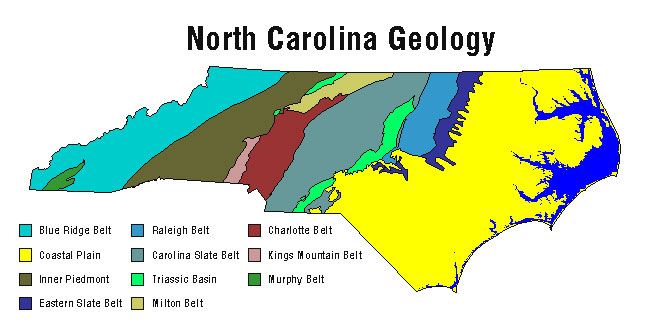How Was the Blue Ridge Formed Describe the Tectonic Forces That Shaped the Piedmont Region
Geology
North Carolina's rich geologic history and composition are as dramatic as its topography. The collisions of numerous ancient landmasses resulted in majestic mountains, with their blend of diverse rock types, and the state's expansive coast was formed from the eroded sedimentary remnants of those same peaks. Beneath these impressive features lies an immense wealth of mineral resources deposited by regular geologic activity over hundreds of millions of years.

North Carolina's long and often turbulent geologic history reveals the effects of both plate tectonics and weather. The earth's crust is essentially a crude patchwork of continually shifting plates that collide with one another as new crust is generated. On a regional level, these violent collisions have resulted in orogenies, sites where the crust has been pushed upward to form mountain chains (the Appalachians were formed by three such orogenies that raised their height to nearly 30,000 feet). Geologic evidence suggests that parts of North Carolina-including the oldest known rocks in the state (1.8 billion years old), located in the western Blue Ridge Mountains-were once at the boundaries of plates, although the creation of new crust in the Atlantic Ocean has moved the state's position to the middle of the North American plate.
This system of plate tectonics is further transformed by weather. Exposure to the elements has, over time, worn down much of the once-mighty Appalachians. Rain and melting snow carried the eroded rocks and soil downhill to streams and rivers; these waterways then transported the materials to the coastal plain, where they accumulated and formed the state's extensive beaches and barrier islands.
Modern-day North Carolina is typically divided into three geologic regions with distinct properties. The narrow mountain region in the west is dominated by the Blue Ridge Mountains, part of North America's eastern Appalachian chain. The region's assorted sedimentary, volcanic, igneous, and metamorphic rocks-often dating to widely different eras-are a testament to the periodic disturbances that gave rise to the mountains. Although rains and rivers have taken their toll on the Appalachians, in North Carolina this range includes no fewer than 43 peaks with heights above 6,000 feet; Mount Mitchell, at 6,684 feet, is the highest point in the country east of South Dakota's Black Hills. Among the Blue Ridge Mountains are deposits of feldspar, mica, and other raw materials mined for industrial purposes.
The state's central geologic region, known as the Piedmont Plateau, runs from Alabama to New Jersey but is at its widest (150 miles) in North Carolina. This region, composed mainly of metamorphic and igneous rocks, has been greatly worn down over time, although some isolated outcroppings called monadnocks (including Pilot Mountain and the Uwharries) have withstood erosion. The Carolina Slate Belt reveals evidence of ancient volcanic activity. Gneiss, schist, lithium, clay, sand, gravel, and building stone can be found throughout the piedmont, and gold was once mined there in abundance. The region's hard rock meets the soft sediment of its eastern neighbor at an area known as the "fall line," or "fall zone," which is the site of many rapids and waterfalls.
The coastal plain is North Carolina's largest geologic region, accounting for about 45 percent of the state. During the Mesozoic era, the coastal plain was a broad sloping region well above sea level. Its loose soil continually eroded from rains and streams flowing toward the ocean. During the Cenozoic era and occasionally the Mesozoic era, the ocean covered the lowland and then subsided repeatedly, creating terraces each time. In the modern coastal plain, rivers and streams deposit sediments and sedimentary rocks originating in the mountain region; the sediment becomes deeper and denser near the coast. The movement of rivers is also responsible for shaping the coastal plain's gradual downward slope toward sea level. The region is rich with sand (utilized in industries such as glass-making) and clay; limestone and phosphate (North Carolina's most important mineral resource) are also mined in quantities.
References:
Fred Beyer, North Carolina, the Years before Man: A Geologic History (1991).
J. Wright Horton Jr. and Victor A. Zullo, eds., The Geology of the Carolinas: Carolina Geological Society Fiftieth Anniversary Volume (1991).
Mary-Russell Roberson and Kevin G. Stewart, The Geologic Story of the Carolinas: A Field Guide (2006).
Jasper Leonidas Stuckey, North Carolina: Its Geology and Mineral Resources (1965).
Additional Resources:
"Geology of North Carolina: Selected Resources" University of North Carolina Libraries. http://guides.lib.unc.edu/geolnc
"North Carolina geology." U.S. Geological Survey, U.S. Department of the Interior. http://mrdata.usgs.gov/sgmc/nc.html
Laney, Francis Baker. Bibliography of North Carolina geology, mineralogy and geography, with a list of maps. Raleigh, E.M. Uzzell & Co.1909. https://archive.org/stream/bibliographyofno00lane#page/n7/mode/2up
Buol, S.W. "Formation of Soils in North Carolina." North Carolina State University. http://www.soil.ncsu.edu/about/century/formation.html
"Mineral Resources." North Carolina Geological Survey. http://www.geology.enr.state.nc.us/Mineral%20resources/mineralresources.html
Image Credits:
The different parts of North Carolina's geology. Image from the N.C. Department of Environment and Natural Resources. http://portal.ncdenr.org/web/lr/overview-of-north-carolina-geology
Source: https://www.ncpedia.org/geology
0 Response to "How Was the Blue Ridge Formed Describe the Tectonic Forces That Shaped the Piedmont Region"
Post a Comment